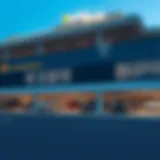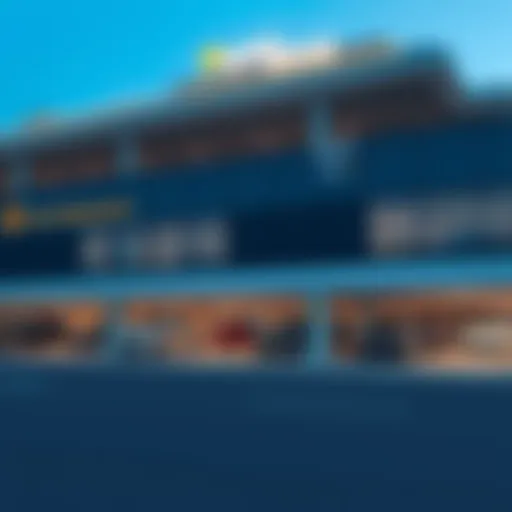Exploring Dubai's Green Metro Line: A Sustainable Journey
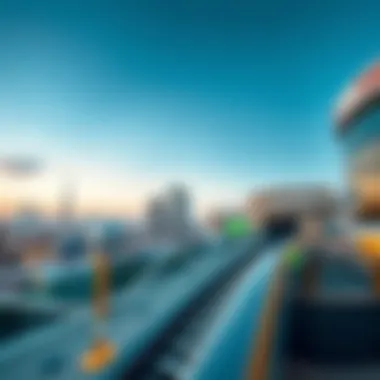
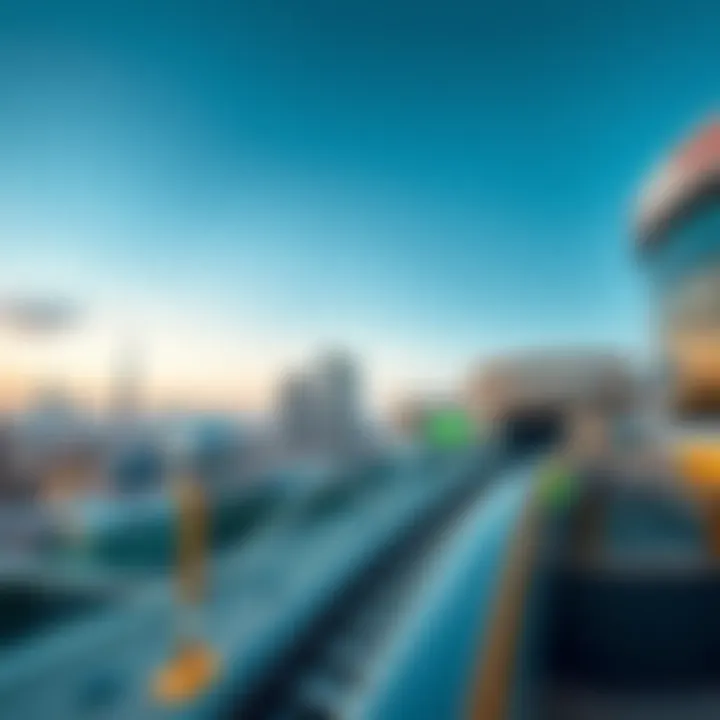
Intro
In the heart of Dubai, the Green Metro Line has emerged as more than just a transit route; it’s a symbol of the city’s commitment to sustainability and modern urban living. Designed to ease congestion while promoting eco-friendly transport options, this metro line serves as a vital artery for both residents and visitors alike.
The Green Metro Line doesn’t just connect locations; it connects communities. The impact it has had on urban mobility and the real estate market cannot be overstated. As potential homeowners, investors, and expatriates seek out properties within reachable distances from metro stations, understanding the Green Metro's influence on property values and urban development is crucial.
This article will peel back the layers surrounding the Green Metro Line, delving into its operational dynamics, the tangible effects on surrounding neighborhoods, and its role as a catalyst for change in Dubai's real estate landscape. We're here to explore how this vibrant network serves as a gateway to sustainable urban mobility and what that means for those considering investing in the thriving Dubai market.
Prelude to the Green Metro Line
Dubai’s Green Metro Line stands as a torchbearer for progressive urban transport, weaving seamlessly into the fabric of the city’s infrastructure. This section aims to delineate the significance of this metro line, not just as a mode of transport, but as a catalyst for sustainable urban growth. In an age where urban congestion is akin to a tightening noose, solutions like the Green Metro Line offer a breath of fresh air.
The Green Metro Line, a crucial component of Dubai’s ambitious transportation framework, serves to connect various neighborhoods and key commercial hubs. Its efficiency is mirrored in the reduction of carbon emissions, skilled urban planning, and the enhancement of public transit alternatives. To appreciate this fully, we must consider two pivotal facets of the metro line:
- Improvement in accessibility and mobility, contributing to a more connected urban landscape.
- The strategic role this transport route plays in the intensifying urban development narrative of Dubai.
Overview of Metro Transportation in Dubai
Dubai's metro system is more than just a collection of trains running on tracks; it’s the backbone of the city's transport strategy. Launched in 2009 with the intention of promoting public transport, the metro system has grown exponentially, now encompassing several lines, including the Green Line. This line stretches through various communities, serving a vast demographic, from tourists exploring the sights to residents commuting to work.
The significance of metro transportation in Dubai can’t be underscored enough. With traffic jams in the city often compared to a game of chess, where every move is critical, the evolution of the metro has placed many pieces on the board. Factors such as convenience, affordability, and time-saving capabilities contribuete to the growing popularity of the system. The strategic placement of metro stations makes accessibility a noteworthy advantage, as many are located near shopping centers, parks, and entertainment venues, firmly rooting the metro in the daily lives of residents.
The Role of Public Transport in Urban Development
Public transportation, particularly in a metropolitan scenario like Dubai, is a fundamental piece of the urban puzzle. The Green Metro Line doesn’t merely fulfill a transport need but serves as a vehicle for urban expansion and transformation. It influences zoning laws, property values, and even the demographics of neighborhoods it touches.
Through improved connectivity, you see a natural uplift in economic activity around the metro stations. Areas previously considered peripheral rapidly become hotspots for investment. Here are a few aspects that highlight the role of public transport in fostering urban development:
- Economic Growth: Enhanced transport links attract businesses looking to capitalize on footfall generated by commuters.
- Urban Revitalization: Underutilized areas near metro lines have witnessed revitalization, with new businesses emerging and habitats rejuvenating.
- Reduction in Traffic Congestion: With more people choosing public transit over personal vehicles, the volume of cars on the roads diminishes, leading to smoother commutes.
In summary, the Green Metro Line isn't just another transit option. It's an integral part of a larger strategy to improve urban living, reduce reliance on automobiles, and promote a sustainable future. Understanding these dynamics reveals how vital this metro line is not only for Dubai's infrastructure but also for its people and their lifestyle.
Key Features of the Green Metro Line
The Green Metro Line stands as a notable marvel within Dubai's rapidly advancing public transport framework. Not only does it enhance connectivity across the emirate, but it also embodies a commitment to sustainability and a future-focused urban landscape. A thorough grasp of its key features is crucial for investors, homeowners, and urban planners aiming to leverage the benefits presented by this line.
Route and Stations
The Green Metro Line traverses a strategic path through Dubai, linking up several key areas. Beginning from Al Qusais and stretching towards the bustling areas of Dubai Creek and the historic Dubai Old Town, this line encompasses multiple pivotal stations. Significant stops include Dubai Healthcare City, which caters to healthcare professionals and patients alike, and the Dubai Gold Souk, a treasure trove for shoppers and tourists.
Each station is meticulously designed to host ample spaces for riders and ease transitions between different transport options. Pedestrian-friendly features around the stations increase access and comfort. This careful placement of stations not only aims to reduce travel times but also encourages businesses to flourish around these transport hubs, further revitalizing local economies. The strategic route selection facilitates efficient movement for both residents and visitors, transforming the way they experience the city.
Technology and Infrastructure
In this digital era, integrating cutting-edge technology within urban infrastructure is non-negotiable. The Green Metro Line leverages advanced signaling systems that promote safety and efficiency. The driverless trains are engineered with precision, ensuring timely arrivals and departures while maximizing passenger comfort through state-of-the-art cabin designs.
The infrastructure itself incorporates resilient building materials designed to endure the region's challenging climate. Sustainable building practices are evident, aligning with Dubai's vision for a greener and more sustainable urban future. Additionally, digital displays provide real-time updates for passengers, making it easier to navigate the transit system.
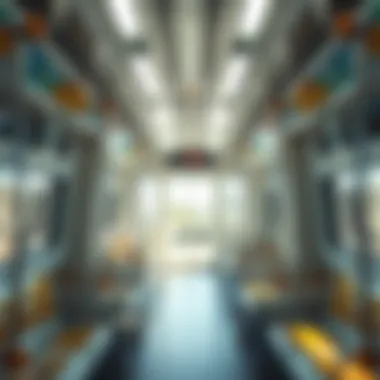
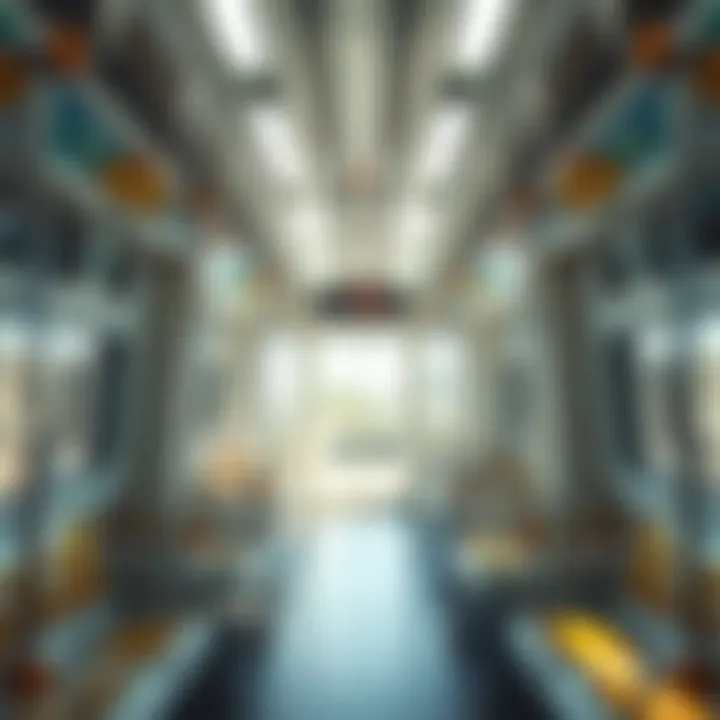
"Public transport is not just about getting from point A to point B; it's about connecting communities and enhancing the urban lifestyle."
Sustainability Initiatives
Sustainability is more than a buzzword; it's at the heart of the Green Metro Line's operations. The line includes initiatives that aim to minimize environmental impact through energy-efficient systems and eco-friendly construction practices. Solar panels grace some station roofs, contributing to energy needs, further driving various sustainability efforts.
Furthermore, the metro line promotes reduced reliance on personal vehicles, contributing to lower carbon emissions in the city. With the aim to encourage more people to utilize public transport, the Green Metro Line is not just a transportation pathway; it is a movement towards a greener urban framework and lifestyle.
In summary, the key features of the Green Metro Line exemplify its importance as a catalyst for urban development and environmental sustainability in Dubai. Understanding these elements prepares potential investors and homeowners to harness the many advantages that come with proximity to this impactful transit option.
Impact on Local Communities
The Green Metro Line plays a pivotal role in shaping local communities within Dubai. Its significance extends beyond mere transportation; it serves as a catalyst for social and economic transformation. This section will explore how the Green Metro Line enhances accessibility and mobility while also revitalizing the surrounding areas.
Accessibility and Mobility Enhancements
One of the most immediate advantages of the Green Metro Line is its ability to improve accessibility for many residents. The introduction of new stations expands the reach of public transport, allowing people from various neighborhoods to connect seamlessly to major hubs. The metro is not just a ride; it’s a means of opening doors.
For instance, imagine a family living in Al Quoz. Before the metro line, they might have struggled to commute to places like Downtown Dubai or Dubai Marina. Now, with the Green Metro Line, these areas are just a few stops away, drastically reducing travel time and hassle. This connection fosters a sense of community across diverse districts.
Furthermore, the accessibility improvements cater especially to lower-income households, where the cost of transportation can be a burden. With an efficient metro system, residents can save money that would have otherwise gone into fuel or parking fees. The ease of movement translates into higher employment opportunities and potentially better living conditions.
Revitalization of Surrounding Areas
Moving past mere transportation, the Green Metro Line acts as a magnet for development, encouraging the revitalization of surrounding areas. Stations often spark growth, leading to increased commercial activities and residential developments nearby. Property owners often see the potential for higher returns on investment due to this natural escalation of interest.
Consider the area around the Al Jaddaf Metro Station. In the years following its establishment, businesses began to flourish, from trendy cafes to local shops aimed at commuters. This transformation attracts more foot traffic, which, in turn, increases revenue for local enterprises. The metro encourages not just development, but organic community growth.
Along with commercial growth comes urban beautification. As property values rise, developers are often incentivized to invest in the aesthetics of the surrounding environment, enhancing parks and public areas. This attention to detail creates inviting spaces where families can spend their leisure time, contributing to the overall quality of life.
"Public transportation, particularly rail systems like the metro, can rejuvenate urban areas, making them more vibrant and livable for all."
Moreover, such revitalization extends to cultural aspects, where new businesses and community centers may arise, offering activities and events that cater to the local populace. The metro becomes more than a travel option; it becomes a unifying thread, weaving together the socioeconomic fabric of the community.
In summary, the impact of the Green Metro Line on local communities in Dubai transcends traditional views of transportation. It enhances accessibility, sparks revitalization, and ultimately cultivates a spirit of community cohesion that resonates deeply with residents and visitors alike.
Integration with Other Transport Modes
Integrating the Green Metro Line with other transport modes is key to creating a cohesive urban mobility network in Dubai. Public transportation does not operate in isolation; rather, it thrives on the interconnectedness of various transportation options. A seamless integration not only enhances the user experience but also encourages more people to opt for public transportation over private vehicles. This switch can significantly reduce traffic congestion, lower emissions, and support sustainable urban development goals.
Connections with Bus Routes
One of the standout features of the Green Metro Line is its connection to Dubai’s extensive bus network. This integration serves multiple benefits:
- Increased Accessibility: The presence of bus stops close to metro stations makes it easy for commuters to switch modes without unnecessary hassle. For instance, a rider can hop off at the Al Jaddaf metro station and catch a bus that goes directly to their office, minimizing travel time.
- Expanded Reach: Buses can serve areas that might not be economically viable for rail development. This expansion means residents in peripheral neighborhoods can still access the grid of efficient urban transport.
- Improved Frequency: With more people using both buses and the metro, bus routes are optimized for higher frequency. The result is less wait time for passengers, making public transport more attractive.
- Unified Ticketing System: Dubai's Roads and Transport Authority (RTA) has introduced a unified fare system. This means a single Nol card can be used across various modes of transport, making payment processes user-friendly and encouraging diverse travel.
Linkages to Water Transport
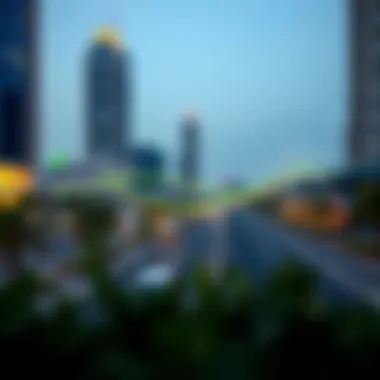
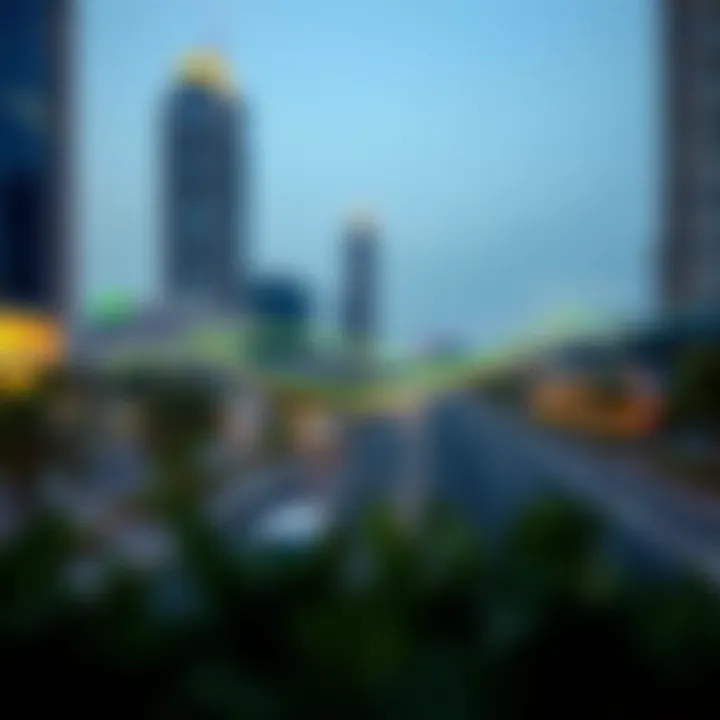
Dubai is not just about land; it embraces its beautiful coastline. The Green Metro Line also links with water transport, adding another layer of convenience for residents and tourists alike.
- Water Taxis and Ferries: Stations like Dubai Marina give easy access to water taxis and ferries. This is vital for tourists looking to explore the city's waterfront without the hassle of road traffic. It promotes the idea that the city is navigable not just by roads but also through its scenic waterways.
- Environmental Benefits: Utilizing water transportation helps to further reduce carbon emissions. By encouraging riders to take to the water rather than land, the metro supports eco-friendly transit solutions.
- A Scenic Mode of Travel: There's more than just practicality here. Taking a ferry gives residents and visitors a picturesque view of the city’s skyline, enhancing the overall travel experience.
Influence on Real Estate Market
The relationship between transit and real estate values is often like two peas in a pod, especially when it comes to the Green Metro Line in Dubai. As cities grow and evolve, having reliable public transport isn't just a luxury; it becomes a necessity that influences how people choose where to live and invest. Properties within arms' reach of metro stations frequently see increased desirability, not only because of convenience but also due to the potential for higher returns on investment.
Property Value Trends Near Green Line Stations
Analyzing property values close to Green Metro Line stations reveals a distinct pattern that investors and homeowners ought to pay attention to. Typically, areas near these stations showcase an upward trajectory in property prices. This can be attributed to a mix of factors such as improved accessibility and the resultant demand from both local and expatriate communities.
For instance, neighborhoods like Al Quoz and Business Bay have seen noticeable appreciation. A flat that was once listing for AED 900 per square foot may now fetch AED 1,200 or more due to this surge in interest.
Key factors influencing property values include:
- Proximity to metro stations, reducing commuting time for residents
- Increased foot traffic, benefiting local businesses
- Enhanced lifestyle amenities emerging in the vicinity due to higher demand
Moreover, statistical data shows that properties near transit hubs generally have faster selling times. If a family is looking at buying a home and notices a property's closeness to a Green Line station, their interest may pivot based on that very convenience. This means quicker sales and jumping prices, creating a robust market dynamic.
Investment Opportunities in Proximate Developments
For savvy investors, the Green Metro Line opens up a goldmine of opportunities. As local development intensifies around metro stations, new residential and commercial projects are increasingly becoming viable options for investment. After all, where there's a metro, there's a market.
As developers capitalize on this shift, they often initiate projects that cater to various demographics—luxury apartments, affordable housing, and even mixed-use developments. With a range of options available, investors can find opportunities that align with their portfolios.
Some noteworthy investment angles include:
- Purchasing properties in emerging neighborhoods set to benefit from metro-related infrastructure
- Spotting trends in areas slated for future station expansions, where property values will likely increase
- Investing in commercial properties that align with increasing foot traffic from metro users, such as cafes or retail units
It's crucial for investors to conduct thorough due diligence, analyzing market conditions and potential growth patterns. Additionally, connecting with local real estate agencies or utilizing resources like Dubai Land Department can provide valuable insights and data points essential for making informed decisions.
"Public transport isn't a mere convenience; it's a catalyst for investment. The Green Metro Line is not just about travel, it's about enhancing the landscape of Dubai's real estate market."
Overall, the influence of the Green Metro Line on the real estate market is profound, serving as both a predictor of rising values and a beacon for investment opportunities. As the line continues to expand, those paying attention will find a wealth of potential awaiting them right along the tracks.
The Future of the Green Metro Line
The Green Metro Line is more than a rail track; it's a vital thread in the fabric of Dubai's urban landscape. As cities around the world rush to adapt to both population growth and environmental concerns, understanding the future of this metro line takes center stage. For investors, homeowners, and urban planners alike, this future holds endless possibilities. Its development promises to enhance mobility, improve quality of life, and contribute to an eco-friendly urban environment.
Expansion Plans and New Stations
Dubai's ambition doesn't stop at its existing infrastructure. More stations are planned to extend the Green Metro Line, enhancing accessibility and reach. Proposed stations aim at connecting not only business hubs but also educational institutions and recreational areas.
- Potential New Stops: Several stations are on the drawing board, including areas that boast a mix of residential communities and commercial developments. For instance, a station near Mohammed bin Rashid City could address both commuter needs and tourism, given its proximity to entertainment venues.
- Connecting Hidden Gems: This expansion will enable connections to lesser-known attractions, putting local cultures and businesses in the spotlight. This not just serves the commuter but also bolsters local economies.
These plans are a direct response to the increasing demand for integrated urban transportation solutions that allow residents to traverse the city seamlessly. Developers focused on areas near these new stations are likely to see increased interest, making it a ripe opportunity for investment.
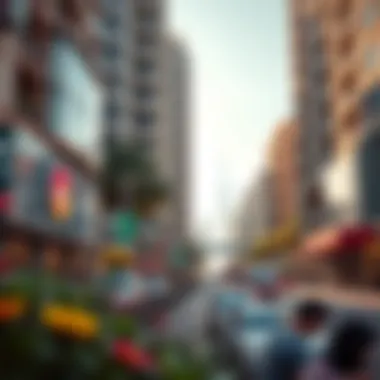
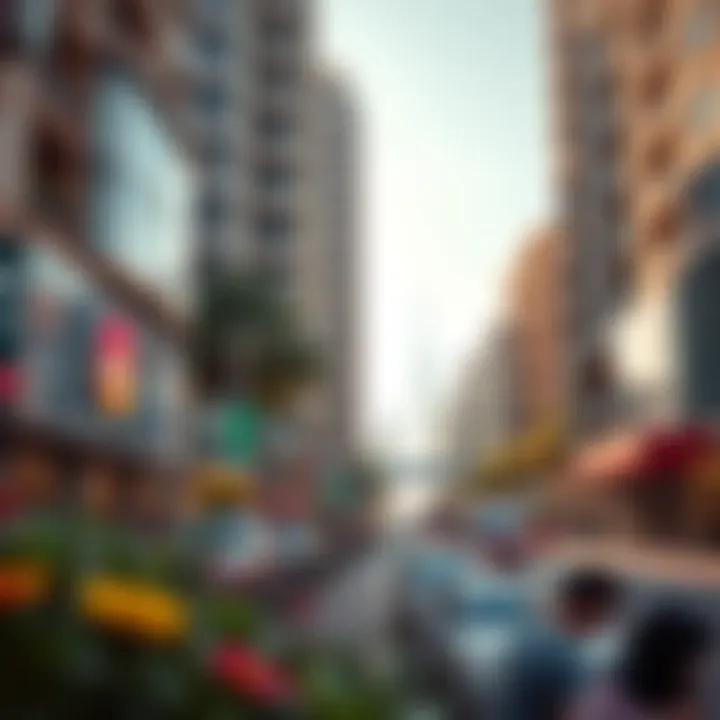
Long-Term Urban Planning Strategies
Long-term urban planning strategies play a crucial role in the progression of the Green Metro Line. These strategies not only determine how the metro integrates into the sprawling landscape but also consider the holistic growth of Dubai.
- Sustainable Developments: Initiatives to build eco-friendly residential projects near metro stations reflect a shift toward sustainability. This aligns with Dubai's broader goal of becoming one of the top cities for sustainable living.
- Smart Technology Integration: Embracing smart technologies such as real-time transit data and automated operations further promises to enhance user experience.
- Collaborative Frameworks: Partnerships between public sectors and private developers can drive effective strategies for maximizing potential near the Green Line. Improved transit-oriented developments can influence both the property market and community living.
Engaging stakeholders, from government bodies to private developers, is vital for creating a well-rounded approach towards future developments surrounding the Green Metro Line. An informed, strategic outlook can lead to not only economic benefits but also an improved quality of urban life, benefitting residents and visitors alike.
Understanding the future trajectory of the Green Metro Line is essential for various stakeholders. As this line expands and evolves, it opens a wealth of opportunities that encourage a greener, more connected metropolitan experience.
Challenges and Considerations
The development and operation of the Green Metro Line in Dubai involve navigating a variety of challenges and considerations that are crucial to its ongoing success. As the city pushes towards its goal of sustainable urban mobility, understanding these hurdles helps illuminate the complexities involved in maintaining a public transportation infrastructure that meets the needs and expectations of its residents and visitors. This segment provides a detailed examination of the challenges faced and underscores their significance in making the Green Metro a pivotal element in Dubai's urban landscape.
Maintenance and Operational Hurdles
One of the primary challenges faced in operating the Green Metro Line is the need for constant maintenance and operational efficiency. With the demands of a bustling metropolitan environment, the metro systems must function seamlessly to avoid disruptions that can frustrate commuters. Regular maintenance schedules must be robust enough to address wear and tear, particularly in systems that are subjected to high volumes of passenger traffic.
Moreover, technological upgrades are vital. As the urban fabric continues to evolve, incorporating advanced technology into the metro's operations helps ensure safety and efficiency. This includes not only enhancing the train systems themselves but also upgrading signaling and control systems. Such improvements can come with significant costs and require careful planning and execution.
Training staff to efficiently manage the operations also presents its own set of challenges. It's crucial to equip the workforce with the necessary skills to handle the intricacies of modern transport systems.
"A well-maintained metro is the lifeline of city mobility, ensuring seamless travel for all."
Public Perception and Usage Trends
Public perception of the Green Metro Line significantly influences its usage and overall success. While many commuters appreciate the efficiency of the metro system, there still exist misconceptions and hesitations around its safety and reliability. Some residents may prefer using personal vehicles, believing they offer more control and convenience, especially during peak hours.
To foster a stronger community trust and encourage usage, outreach programs and informational campaigns are essential. These efforts aim to educate the public about the benefits of using the metro, such as reduced carbon footprints and less congestion on the roads. The more citizens understand how the Green Metro can enhance their daily lives, the more likely they are to embrace it as a viable alternative.
Trends in public usage can reveal changing attitudes. For instance, an uptick in metro ridership during specific other events or seasons could indicate a growing acceptance among different segments of society. Similarly, tracking feedback from users can uncover valuable insights that drive future improvements. Paying attention to such trends can help the metro operators adapt services more aligned with community needs.
In summary, addressing maintenance and operational challenges, along with understanding public perceptions and usage trends, is crucial for the continued success of the Green Metro Line. Only by overcoming these issues can Dubai achieve its vision of sustainable urban mobility, creating a future where the metro system is a critical component of the city’s transport network.
Epilogue
The Green Metro Line stands as a cornerstone in Dubai's ambition for sustainable urban mobility. Its development encapsulates not just the modernization of transport infrastructure but also a blueprint for integrating eco-friendly practices into urban life. One cannot overlook its various benefits—enhanced accessibility, reduced traffic congestion, and improved air quality. Each of these elements plays a pivotal role in shaping not only individual lives but the very fabric of the city.
Summation of Benefits of the Green Metro Line
The advantages of the Green Metro Line extend far beyond mere convenience. Here’s a closer look at its impact:
- Accessibility: The line connects key areas of the city, ensuring that residents and visitors alike can move with ease.
- Environmental Impact: Operating on a sustainable model, the Metro contributes to lowering carbon emissions significantly compared to car travel.
- Economic Boost: Increased public transport draws international attention, which can further invite investments into Dubai.
- Balanced Urban Growth: With strategic stations, the Metro promotes equitable development across various districts, preventing overcrowding in any singular area.
"Investing in public transport is investing in the community's future."
These benefits not only enhance the everyday experience of the commuter but also play an instrumental role in the long-term vision for Dubai.
The Metro's Role in Shaping Dubai's Future
The future of Dubai hinges on innovative urban planning, and the Green Metro Line occupies a central role in this vision. It acts as a catalyst for other developments, such as:
- Integration with Smart Technologies: As Dubai leans towards a smart city framework, the Metro can evolve with technologies that enhance user experience, like AI-based real-time scheduling.
- Promoting Sustainable Living: With more people using public transport, there’s a potential shift towards more sustainable living practices in the area surrounding stations.
- Real Estate Development: Elevated property values near Metro stations are anticipated, highlighting the intersection of transportation and real estate dynamics.
- Fostering Community Culture: With improved connections, neighborhoods become more vibrant as people travel to explore various cultural venues and events.
In summation, the Green Metro Line embodies a multifaceted approach to urban life. It connects, sustains, and innovates, making it a vital component in Dubai's future urban scenario. The integration of such a transport system speaks volumes about the city's commitment to advancing its infrastructure and embracing a sustainable, modern way of living.
